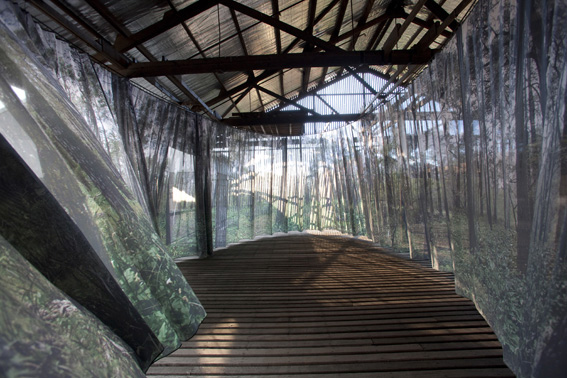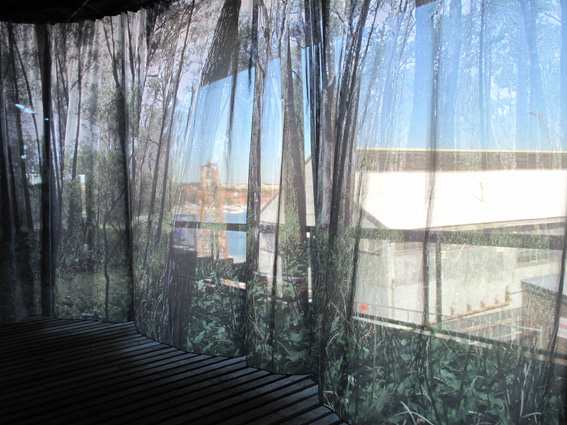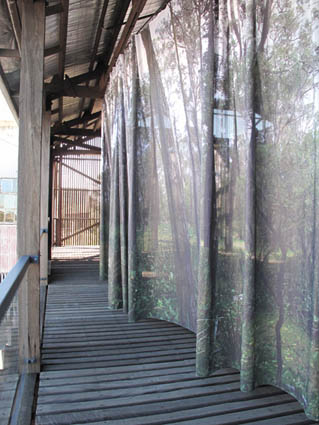Islands of incarceration, 2010
for the Biennale of Sydney, 2010
curated by David Elliott
digital print on polysynthetic fabric, sound produced in collaboration with Dr Cat Hope
Assistance from the DCA, Australia Council for the Arts, Chris Malcolm, Stitches Soft Furnishings and Vanda
View artist talk LINK TEXT
excerpt from catalogue essay - scroll down for more images
Islands of incarceration (2010) is a site-specific installation on Cockatoo Island that continues the artist's interest in these detached pieces of land, these natural prisons and containers of memory. Into this matrix she inserts another story - one that originates in the Ludlow Tuart Forest in Western Australia. She has created an echo of the forest inside a disused timber-drying shed on the plateau of Cockatoo Island. The structure, a timber shell with missing walls that looks simultaneously to be under construction and undergoing deconstruction, houses the ghosts of a different yet linked history.
Ludlow Tuart Forest is a national park and detour on the way from Perth to the Margaret River wine region. It is visited rarely - a place for passing through. As a child she would sit in the back of her parent's car as they drove through the forest along the 'scenic route' between Bunbury and Busselton. At the time she found it beautiful but wanted to exit as quickly as possible. In 2007 when McMillan revisited the Ludlow Tuart Forest, three hours south of her home city Perth, she took a camera and wandered through the bush. She found and photographed a burnt clearing where the smell of ash still lingered; the smell of which perhaps heightened the disquiet experienced by the artist, now burdened with the knowledge that she was standing in the forest where the 1841 Wonnerup Massacre took place. Reports state that here somewhere between 300 and 1000 Wardandi Noongar people were massacred and buried over a period of five years. McMillan's research found that the mass murders had resulted from an incident concerning a white homestead owner who had held a young Noongar girl captive in his home to perform domestic duties. After refusing to give back the 13-year old girl the homestead owner George Layman was speared by Gaywer, a senior Wardandi Noongar elder. Gaywer was later beheaded and his head left on a stick as a warning to other Wardandi Noongar people.
The majestic trees of the Ludlow Tuart Forest appear in Islands of incarceration as a mirage, gradually taking shape as you approach the site on the top of the island. The installation consists of a panoramic photograph of the forest printed onto a thin, polysynthetic fabric. The fabric is suspended in an elliptical shape that sweeps the floor; a shape that encircles, protects, harbours, contains, but is itself penetrated by light and therefore vulnerable. It is like a large veil, caught by the wind that gusts through. The vertical rhythm of the trees has its counterpart in the irregular timber slats that are the aging and weathered bones of the building. There is an ambient sound not unlike distant thunder, intruding subtly into your consciousness. Standing in the space it feels like a cipher for memory itself. In the way memories can be felt so strongly in one moment and then not at all, dissipating and reforming, sometimes leaving an ache. Here the ache is the trauma that lingers in landscape and can be felt as an unsettling, phantom pain. The soft-forming folds, the shadows that stripe the curtains at certain times of day and the trees themselves are beautiful. What it represents is harsh. The presence (and absence) of the trees reminds you of the irrevocable changes wrought on the landscape in the building up of civilisations here and elsewhere.
Change and displacement. Ghosts. The shed is a relic of the island's past - in the 171 years since the colonial Governor Sir George Gipps chose it as the site of the colony's new penal establishment, it has been a prison, industrial school, reformatory for girls, gaol and maritime shipbuilding yard. At one stage Cockatoo Island was the biggest shipbuilding yard in Australia, ceasing its maritime activities in the early 1990s. The ghosts here are felt on the island in the abandoned machinery, in the cavernous halls and in weathered sandstone of the old convict courtyard. By bringing an apparition of Ludlow Tuart Forest into an abandoned timber-drying shed in Sydney Harbour McMillan makes us aware of the histories that inhabit all corners of this country, and that are everywhere, all the time, all around.
Melissa Ratliff
July 2010




for the Biennale of Sydney, 2010
curated by David Elliott
digital print on polysynthetic fabric, sound produced in collaboration with Dr Cat Hope
Assistance from the DCA, Australia Council for the Arts, Chris Malcolm, Stitches Soft Furnishings and Vanda
View artist talk LINK TEXT
excerpt from catalogue essay - scroll down for more images
Islands of incarceration (2010) is a site-specific installation on Cockatoo Island that continues the artist's interest in these detached pieces of land, these natural prisons and containers of memory. Into this matrix she inserts another story - one that originates in the Ludlow Tuart Forest in Western Australia. She has created an echo of the forest inside a disused timber-drying shed on the plateau of Cockatoo Island. The structure, a timber shell with missing walls that looks simultaneously to be under construction and undergoing deconstruction, houses the ghosts of a different yet linked history.
Ludlow Tuart Forest is a national park and detour on the way from Perth to the Margaret River wine region. It is visited rarely - a place for passing through. As a child she would sit in the back of her parent's car as they drove through the forest along the 'scenic route' between Bunbury and Busselton. At the time she found it beautiful but wanted to exit as quickly as possible. In 2007 when McMillan revisited the Ludlow Tuart Forest, three hours south of her home city Perth, she took a camera and wandered through the bush. She found and photographed a burnt clearing where the smell of ash still lingered; the smell of which perhaps heightened the disquiet experienced by the artist, now burdened with the knowledge that she was standing in the forest where the 1841 Wonnerup Massacre took place. Reports state that here somewhere between 300 and 1000 Wardandi Noongar people were massacred and buried over a period of five years. McMillan's research found that the mass murders had resulted from an incident concerning a white homestead owner who had held a young Noongar girl captive in his home to perform domestic duties. After refusing to give back the 13-year old girl the homestead owner George Layman was speared by Gaywer, a senior Wardandi Noongar elder. Gaywer was later beheaded and his head left on a stick as a warning to other Wardandi Noongar people.
The majestic trees of the Ludlow Tuart Forest appear in Islands of incarceration as a mirage, gradually taking shape as you approach the site on the top of the island. The installation consists of a panoramic photograph of the forest printed onto a thin, polysynthetic fabric. The fabric is suspended in an elliptical shape that sweeps the floor; a shape that encircles, protects, harbours, contains, but is itself penetrated by light and therefore vulnerable. It is like a large veil, caught by the wind that gusts through. The vertical rhythm of the trees has its counterpart in the irregular timber slats that are the aging and weathered bones of the building. There is an ambient sound not unlike distant thunder, intruding subtly into your consciousness. Standing in the space it feels like a cipher for memory itself. In the way memories can be felt so strongly in one moment and then not at all, dissipating and reforming, sometimes leaving an ache. Here the ache is the trauma that lingers in landscape and can be felt as an unsettling, phantom pain. The soft-forming folds, the shadows that stripe the curtains at certain times of day and the trees themselves are beautiful. What it represents is harsh. The presence (and absence) of the trees reminds you of the irrevocable changes wrought on the landscape in the building up of civilisations here and elsewhere.
Change and displacement. Ghosts. The shed is a relic of the island's past - in the 171 years since the colonial Governor Sir George Gipps chose it as the site of the colony's new penal establishment, it has been a prison, industrial school, reformatory for girls, gaol and maritime shipbuilding yard. At one stage Cockatoo Island was the biggest shipbuilding yard in Australia, ceasing its maritime activities in the early 1990s. The ghosts here are felt on the island in the abandoned machinery, in the cavernous halls and in weathered sandstone of the old convict courtyard. By bringing an apparition of Ludlow Tuart Forest into an abandoned timber-drying shed in Sydney Harbour McMillan makes us aware of the histories that inhabit all corners of this country, and that are everywhere, all the time, all around.
Melissa Ratliff
July 2010



